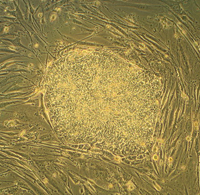 In Oliver Brüstle v Greenpeace (Case 34/10) the Court of Justice of the European Union (CJEU) ruled that any non-fertilised but parthenogenically stimulated human ovum constitutes a "human embryo" within the meaning of Article 6(2)(c) as it is capable of commencing the process of development of a human being in the same way as an embryo created by fertilisation of an ovum. Clarification of the scope term "human embryo" is important as it will determine whether technologies involving stem cells obtained from parthenogenically stimulated ova, but which cannot develop into a human being, are excluded from patentability as "human embryos" under the Directive.
In Oliver Brüstle v Greenpeace (Case 34/10) the Court of Justice of the European Union (CJEU) ruled that any non-fertilised but parthenogenically stimulated human ovum constitutes a "human embryo" within the meaning of Article 6(2)(c) as it is capable of commencing the process of development of a human being in the same way as an embryo created by fertilisation of an ovum. Clarification of the scope term "human embryo" is important as it will determine whether technologies involving stem cells obtained from parthenogenically stimulated ova, but which cannot develop into a human being, are excluded from patentability as "human embryos" under the Directive.
 The UK High Court has now referred this question to the CJEU. The referral stems from the UK Intellectual Patent Office's decision to refuse two patent applications filed by International Stem Cell Corporation (ISCC) relating to human stem cells. The technology covered by the patent applications related to unfertilised human ova, subject to division and further development only by parthenogenesis (a form of asexual reproduction whereby embryos can grow and develop without fertilisation). The ova produced by the methods covered by the patent applications only contained pluripotent cells. These cells undergo division as would an embryo formed by fertilization, but are incapable of developing into a human being. The patent applications were refused by the UKIPO on the grounds that the inventions were excluded from patentability under paragraph 3(d) of Schedule A2 to the Patents Act 1977 as covering the use of human embryos.
The UK High Court has now referred this question to the CJEU. The referral stems from the UK Intellectual Patent Office's decision to refuse two patent applications filed by International Stem Cell Corporation (ISCC) relating to human stem cells. The technology covered by the patent applications related to unfertilised human ova, subject to division and further development only by parthenogenesis (a form of asexual reproduction whereby embryos can grow and develop without fertilisation). The ova produced by the methods covered by the patent applications only contained pluripotent cells. These cells undergo division as would an embryo formed by fertilization, but are incapable of developing into a human being. The patent applications were refused by the UKIPO on the grounds that the inventions were excluded from patentability under paragraph 3(d) of Schedule A2 to the Patents Act 1977 as covering the use of human embryos.
 ISCC argued that the UKIPO had incorrectly applied the test of "capable of commencing the process of development of a human being" not only to technologies involving embryos formed by fertilisation but also to technologies involving parthenogenesis and other processes such as somatic-cell nuclear transfer in non-fertilised ova. ISCC argued that the correct application of the test was to exclude only technologies that enable the commencement of development which leads to a human being and not those technologies which enable the commencement of a process of development even if that process is incapable of leading to a human being.
ISCC argued that the UKIPO had incorrectly applied the test of "capable of commencing the process of development of a human being" not only to technologies involving embryos formed by fertilisation but also to technologies involving parthenogenesis and other processes such as somatic-cell nuclear transfer in non-fertilised ova. ISCC argued that the correct application of the test was to exclude only technologies that enable the commencement of development which leads to a human being and not those technologies which enable the commencement of a process of development even if that process is incapable of leading to a human being.
The UKIPO considered that the test laid down by the CJEU may apply only on the start of a development process but the exclusion did not necessarily require completion of the process which results in the birth of a human being in order for the method to be excluded. However, the UKIPO submitted that the test developed by the CJEU was unclear and supported the referral of the question to the CJEU for clarification on the matter.
When considering the Oliver Brüstle v Greenpeace case, the evidence before the CJEU was that parthenotes (bundle of cells produced following parthenogenises of an ova) have the potential to create a human being. This is in contrast to the present case where it was accepted by all parties that the parthenotes produced by the methods of the invention were incapable of normal development.
On appeal, the Judge was persuaded by the view that parthenotes were not the same as fertilised ova at any stage and that if the process of development was incapable of leading to a human being, then it should not be excluded from patentability as a 'human embryo'. The Judge therefore allowed the referral to the CJEU to seek clarification of the test.
It is apparent that the ISCC case turns on different facts to the Brustle decision since the technology covered by the ISCC patent applications produce parthenotes which cannot develop into a human being. The UK High Court Judge stated that "excluding processes of development which are incapable of leading to a human being from patentability would not strike the purported balance sought by the Biotech Directive."
We will report again when the CJEU's judgement is handed down.
This report comes from European Patent Attorneys at WP Thompson & Co., 55 Drury Lane, London UK. Further details and commentary can be obtained from Gill Smaggasgale, a partner at the firm.